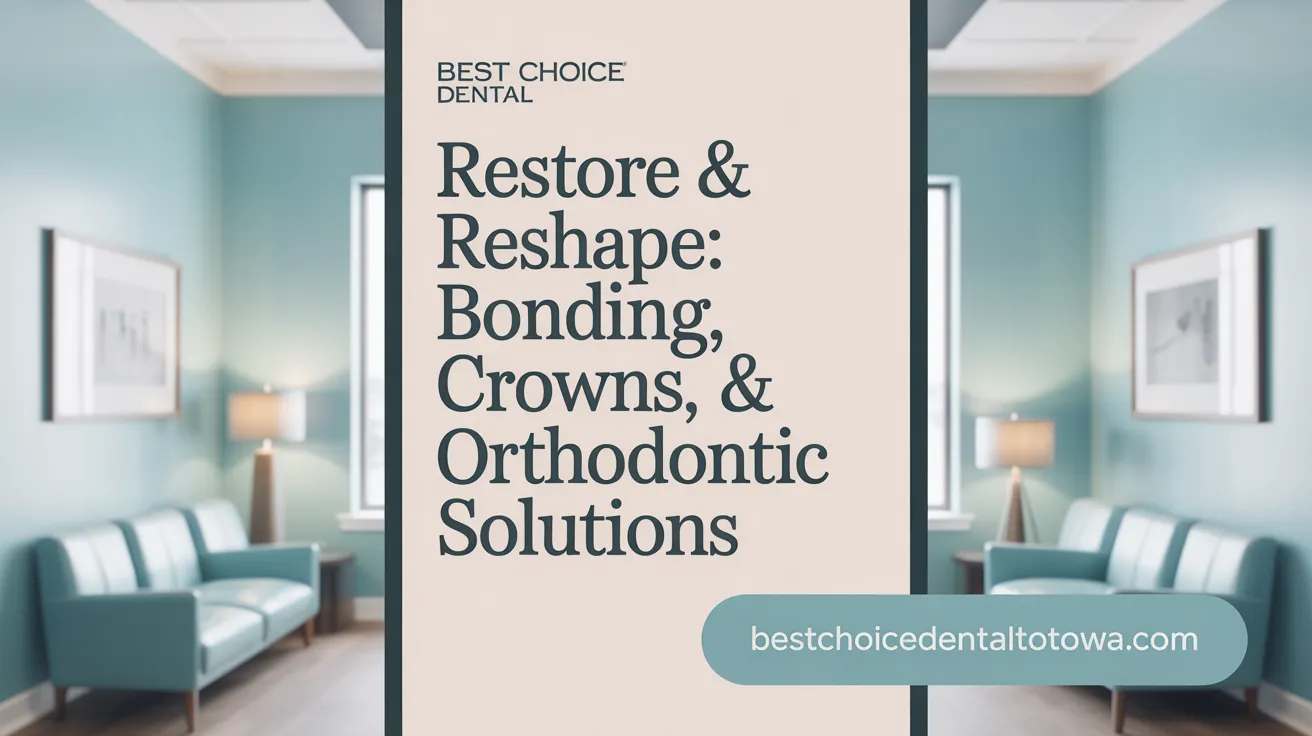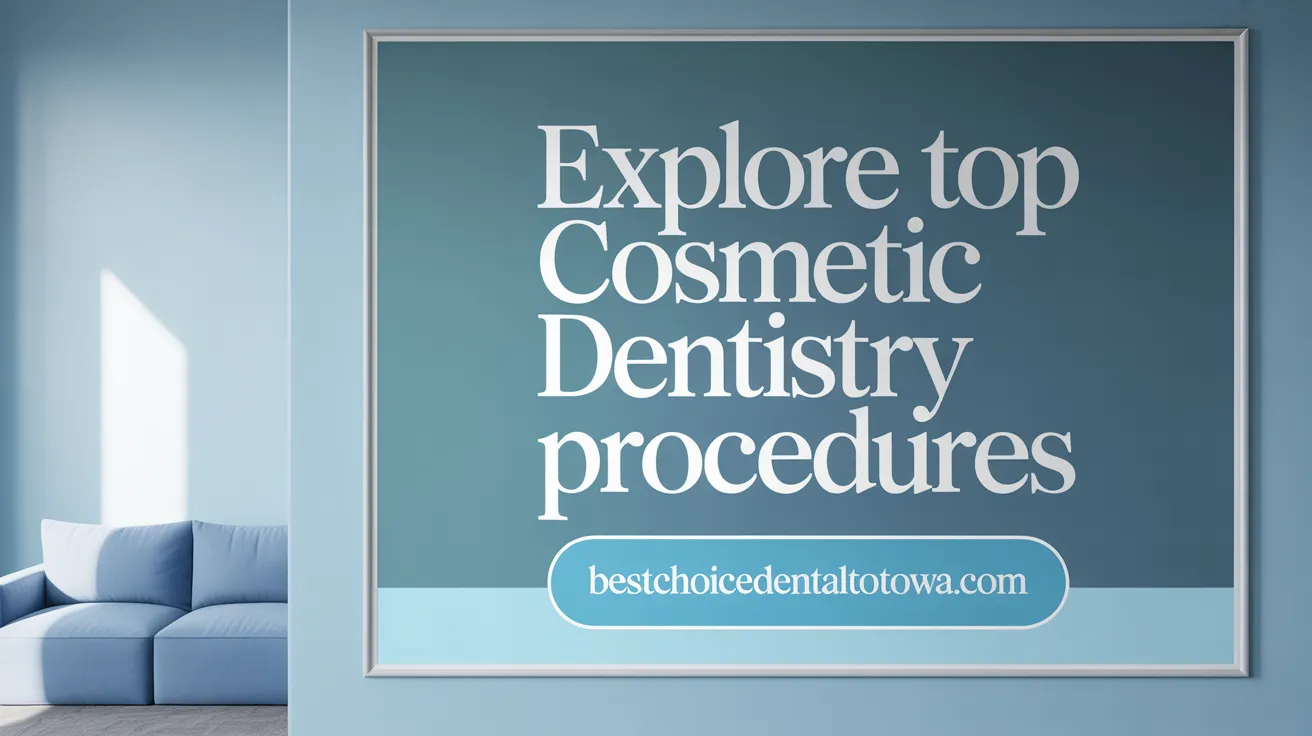Introduction to Cosmetic Dentistry Treatments
Cosmetic dentistry offers a variety of procedures designed to enhance the appearance, function, and confidence related to your smile. From non-invasive whitening treatments to transformative veneers and restorative implants, the field provides solutions tailored to different dental concerns. This article explores three core types of cosmetic dentistry treatments, shedding light on their purposes, processes, benefits, costs, and outcomes to help you make informed decisions about improving your smile.
Key Facts on Cosmetic Dentistry
- Professional teeth whitening uses high-strength bleaching agents like hydrogen peroxide for dramatic, quick results.
- At-home whitening involves custom trays with professional-grade gel for gradual, convenient whitening.
- Over-the-counter products like strips and toothpastes are less potent but help maintain surface whiteness.
- Active agents, hydrogen peroxide and carbamide peroxide, break down stains through oxygen release inside enamel.
- Professional whitening results last 1-3 years, while at-home and OTC treatments offer several months to a year of improvement.
- Teeth whitening is generally safe under dental supervision, with temporary sensitivity as a common side effect.
- Candidates for whitening should have healthy teeth and gums; those with intrinsic stains may need veneers or crowns.
- Dental veneers, including porcelain and composite, are durable and restore color, shape, and cover imperfections.
- Veneers involve enamel removal; no-prep options (Lumineers) are minimally invasive, offering up to 20 years lifespan.
- Recent advancements include ultra-thin veneers, CAD/CAM technology, digital smile design, and improved bonding for better outcomes.
1. Teeth Whitening: Brighten Your Smile Safely and Effectively

Professional in-office whitening
Professional teeth whitening is performed by experienced dentists using high-strength bleaching agents. This method often involves applying a gel containing hydrogen peroxide or carbamide peroxide directly to the teeth, sometimes activated with a special light or laser. The procedure can deliver dramatic results in about an hour, often whitening teeth by up to eight shades. It is considered the most effective and quickest way to achieve a visibly brighter smile.
At-home whitening kits
Dentists also offer custom whitening trays for use at home. These trays are molded to fit your teeth precisely and are filled with professional-grade bleaching gel. Treatment duration typically spans a few days to a few weeks, depending on the desired shade. This method allows for gradual whitening at your convenience and is usually recommended as a follow-up or maintenance after in-office treatments.
Over-the-counter whitening products
Available widely in drugstores, OTC products include whitening strips, gels, toothpastes, and rinses. Strips are pre-coated with peroxide gel and adhere to the teeth for a specified period, while whitening toothpastes and rinses contain mild abrasives and low peroxide levels. These products are less potent than professional options but can help reduce surface stains and maintain whiteness between professional treatments.
Active whitening agents and their function
The primary active ingredients in whitening products are hydrogen peroxide and carbamide peroxide. These chemicals penetrate the enamel and release oxygen molecules, which react with the colored compounds causing stains inside the teeth. This chemical reaction breaks down the stains, resulting in a whiter appearance. Higher concentrations of these agents in professional products lead to faster and more noticeable whitening.
Effectiveness and duration of results
Results vary depending on the method, initial tooth color, and lifestyle habits. Professional in-office whitening generally produces the most significant and immediate improvement, lasting from one to three years with proper care. At-home treatments offer moderate whitening effects lasting several months to a year. OTC products provide milder changes and may require regular use to maintain results.
Safety considerations and potential side effects
When performed correctly under dental supervision, teeth whitening is safe. Common side effects include temporary tooth sensitivity and mild gum irritation, which usually resolve after treatment. Overuse or improper application of whitening agents can exacerbate sensitivity or cause surface roughening of enamel. It is crucial to follow guidelines and consult your dentist before starting whitening treatments to ensure suitability.
Suitability and candidate evaluation
Ideal candidates are those with healthy, unrestored teeth and no gum disease or cavities. Patients with significant staining from intrinsic causes like medication or aging may see limited results and might be better suited for veneers or crowns. Dentists evaluate oral health, existing restorations, and aesthetic goals before recommending a whitening approach, ensuring both safety and effective outcomes.
2. Dental Veneers: Durable Solutions for Cosmetic Perfection

What are the different types of veneers?
Veneers come in several varieties, each suited to different cosmetic needs and preferences.
- Porcelain Veneers: These are the most popular due to their durability and natural appearance. Made from high-quality ceramic, they resist stains better than other types and often last between 10 to 15 years.
- Composite Resin Veneers: Crafted from tooth-colored composite material, they are less expensive and can often be placed in a single visit. Typically, they last around 5 to 7 years.
- No-Prep Veneers (Lumineers): These ultra-thin veneers require minimal to no enamel removal, making the process less invasive. They are suitable for minor cosmetic adjustments and can last up to 20 years.
- Removable or Snap-on Veneers: These are custom-made devices that fit over natural teeth and can be taken out. They are less durable and primarily used for temporary aesthetic purposes.
How is the veneer placement procedure performed?
The process generally involves several steps:
- Consultation: The dentist assesses the teeth and discusses desired aesthetic outcomes.
- Tooth Preparation: A small amount of enamel—usually about 0.5 mm—is removed from the front surface of the teeth to ensure a proper fit.
- Impressions: Precise molds are taken of the prepared teeth to create custom veneers.
- Fabrication: Veneers are manufactured in a dental lab based on the impressions, matching the shade and shape to your natural teeth.
- Bonding: During the second visit, the veneers are bonded to your teeth using a strong dental adhesive and cured with a special light, ensuring a durable fit.
Proper care and regular checkups keep veneers looking their best.
What are the advantages of dental veneers?
Veneers can dramatically enhance your smile by improving the color, shape, and size of teeth.
- They offer a natural appearance due to their translucency.
- Resistant to staining from foods and drinks.
- Provide a long-lasting solution, especially the porcelain variety.
- Can cover a variety of cosmetic issues like chips, cracks, gaps, and discoloration.
- Usually require minimal removal of natural tooth structure when no-prep or Lumineers are used.
See more on Benefits of dental veneers.
What are the risks and considerations?
Veneers involve removing some enamel, which is irreversible.
- Increased sensitivity, particularly to temperature changes, can occur temporarily.
- There’s a small risk of veneer dislodgement.
- Late replacements or repairs are often needed as veneers tend to last between 10 to 15 years.
- Not suitable for teeth with existing decay or gum disease.
Read further on Risks of veneers.
What factors influence the cost of veneers?
The price varies based on:
| Material Type | Approximate Cost per Tooth | Longevity | Additional Details |
|---|---|---|---|
| Porcelain | $900–$2,500 | 10–15 years | Most durable and stain-resistant |
| Composite Resin | $400–$1,100 | 5–7 years | Less costly, easier repairs |
| No-Prep (Lumineers) | $800–$2,000 | Up to 20 years | Minimally invasive |
| Removable | $300–$3,500 per arch | 1–5 years | Used temporarily |
Cost factors include the number of teeth, material choice, and complexity of the case.
How do you care for veneers?
Caring properly can extend their lifespan:
- Maintain excellent oral hygiene with brushing, flossing, and regular dental visits.
- Avoid biting or chewing hard foods and objects.
- Use non-abrasive toothpaste.
- Limit intake of staining foods and beverages like coffee, tea, and red wine.
- Wear protective gear during sports.
Promptly address any issues such as sensitivity or veneer damage.
See tips on Caring for dental veneers.
What are recent advancements in treatment materials and techniques?
Innovations include ultra-thin veneers that require no or minimal enamel removal, thanks to new ceramic formulations like lithium disilicate.
CAD/CAM technology allows for precise, quicker fabrication of veneers with high success rates.
Bonding techniques have improved, enhancing the durability and lifespan of veneers.
Recent materials aim to combine strength, aesthetics, and minimally invasive procedures, making veneers more accessible and longer-lasting.
| Aspect | Explanation |
|---|---|
| Material Innovations | Use of lithium disilicate and CAD/CAM technology |
| Procedure Advances | No-prep and minimal prep options |
| Longevity | Up to 20 years with proper care |
| Cost Trends | Increasing availability of affordable options |
Veneers continue to evolve, offering durable, natural-looking solutions that cater to various aesthetic and functional needs, making them an effective choice for a radiant smile without extensive dental work.
3. Restorative and Reshaping Cosmetic Procedures: Bonding, Crowns, and Orthodontics

What are the purposes and longevity of dental bonding?
Dental bonding involves applying a tooth-colored resin to fix chips, cracks, stains, or reshape teeth. This minimally invasive procedure typically lasts between five to eight years when properly cared for. It is an affordable and quick way to improve the appearance of minor imperfections, often completed in a single appointment. For more details, you can refer to Cosmetic dentistry procedures and Dental Bonding.
When are crowns and caps used for damaged teeth?
Crowns, also known as caps, are custom-made covers placed over damaged or decayed teeth to restore their shape, size, and strength. They are often used after root canal treatment, to cover large fillings, or to repair severely chipped or cracked teeth. Crowns are made from materials like ceramic, porcelain-fused-to-metal, or full metal, and generally last around 10 to 15 years with good oral hygiene. For more on this, see Dental crowns - Types and materials and Dental crowns information.
How do dental implants work for missing teeth?
Dental implants are titanium posts surgically inserted into the jawbone, acting as artificial roots. They provide a stable foundation for attaching crowns, bridges, or dentures, supporting natural chewing and speaking functions. Implants are a durable, long-term solution for tooth loss, with a success rate over 95%. The process includes placement, healing, and attachment of the artificial tooth, often taking several months. See more about Dental implants overview and Dental Implants Information.
What orthodontic treatments are available, including Invisalign and braces?
Orthodontic options like traditional braces and Invisalign clear aligners help straighten teeth, correct bites, and resolve misalignments. Braces use brackets and wires, while Invisalign employs a series of custom clear trays that are removable and nearly invisible. These treatments are suitable for both teens and adults and typically require several months to a few years depending on case complexity. Learn more about Orthodontic treatments options and Invisalign clear aligners.
Procedure overviews and suitability for patients
Dental bonding is ideal for quick repairs of small imperfections and is suitable for most ages. Crowns are recommended for damaged or heavily restored teeth, requiring preparation of the natural tooth. Implants are suitable for patients with sufficient jawbone density and healthy gums. Orthodontic treatments are appropriate for correcting alignment issues; a dentist or orthodontist assesses suitability based on case severity. For comprehensive cosmetic dentistry options, consult Cosmetic dentistry procedures and Dental veneers overview.
Benefits for function and aesthetics
These procedures not only improve smile appearance but restore proper function—helping with biting, chewing, and speech. Crowns and implants provide structural integrity, while braces and aligners ensure correct jaw alignment. Bonding and veneers cover flaws, creating a more attractive and confident smile. Explore more at Benefits of dental veneers and Cosmetic dentistry benefits.
Cost considerations and treatment outcomes
Costs vary: bonding is usually under $1,000, crowns range from $800 to $1,700 per tooth, implants can cost over $3,000, and orthodontic treatments range between $3,000 and $8,000. Long-term success depends on proper maintenance, with implants and crowns lasting over a decade, and braces or aligners providing lasting correction. Regular dental visits and diligent oral hygiene help optimize results. For cost details, see Cost of dental veneers and crowns and Orthodontics and cosmetic dentistry costs.
Overview of Main Cosmetic Dentistry Procedures

What are the main cosmetic dentistry procedures available?
The main cosmetic dentistry procedures available include teeth whitening, veneers, dental bonding, crowns, implants, and orthodontics. Teeth whitening effectively lightens teeth and addresses surface stains, while veneers are thin ceramic shells that conceal chips, cracks, and discoloration for a natural appearance. Bonding involves applying tooth-colored resin to repair chips, cracks, or irregular shapes, and crowns are full caps used to restore tooth structure and function. Dental implants replace missing teeth with titanium posts supporting crowns, providing a permanent solution. Additionally, orthodontic treatments like Invisalign or braces can straighten teeth and improve overall smile aesthetics.
What purposes do different types of cosmetic dental treatments serve?
Different types of cosmetic dental treatments serve various aesthetic and functional purposes to enhance a person's smile. Teeth whitening treatments brighten stained or discolored teeth, providing a more youthful appearance. Veneers, crowns, and bonding improve shape, conceal chips, cracks, or gaps, and restore damaged teeth, while gum contouring corrects the gum line to create a balanced smile. Orthodontic procedures, such as braces or clear aligners, straighten misaligned teeth and correct bites, improving both function and appearance. Overall, these treatments aim to boost confidence by addressing specific concerns related to the shape, color, alignment, and overall harmony of teeth and gums.
Benefits and Cost Factors in Cosmetic Dentistry

What are the benefits of undergoing cosmetic dental procedures?
Cosmetic dental procedures provide a range of advantages that go beyond just enhancing appearance. They significantly improve the look of teeth, gums, and smiles, which can greatly increase self-confidence and self-esteem. Treatments like teeth whitening, veneers, and bonding can effectively conceal common dental issues such as stains, chips, gaps, and misalignments, resulting in a more even and attractive smile.
In addition to aesthetic improvements, many procedures also offer functional benefits. For instance, restoring damaged teeth with crowns or veneers supports better chewing and speech. Orthodontic options like Invisalign can straighten teeth, making oral hygiene easier and reducing the risk of future problems like gum disease or cavities.
Moreover, certain treatments support overall oral health by correcting bite issues, sealing cracks, and preventing further damage. Many patients experience a boost in personal and professional confidence after their smiles are transformed, which can positively influence social interactions, career opportunities, and mental well-being. Learn more about the benefits of cosmetic dentistry.
What factors affect the cost of veneers and other cosmetic dental treatments?
The cost of cosmetic dental treatments varies widely due to several influencing factors. The specific type of procedure plays a significant role; for example, teeth whitening generally costs less than full-mouth veneers or implants.
Material choice is another major determinant—porcelain veneers tend to be more expensive than composite resin options, but they offer better durability and stain resistance. The complexity of the case is also critical; more intricate procedures that involve correcting multiple issues or multiple teeth naturally cost more.
The experience and reputation of the dentist also influence pricing, with highly skilled practitioners often charging higher fees for their expertise. Geographic location further impacts costs, as urban centers and regions with a higher cost of living typically have higher prices due to increased overheads.
Advancements in technology, such as 3D imaging or CAD/CAM systems, enhance precision and outcomes but can increase the overall treatment cost. Lastly, additional expenses like consultations, follow-ups, and sedation should be considered, noting that most cosmetic procedures are considered elective and not covered by insurance.
Overall, patients should discuss all options with their dentist to understand the costs and benefits tailored to their individual needs. Detailed information on cost and financing options for veneers and other treatments can help.
| Treatment Type | Influencing Factors | Typical Cost Range |
|---|---|---|
| Teeth whitening | Method (in-office or at-home), product strength, case complexity | $200 – $600 |
| Veneers | Material (porcelain vs composite), number of teeth, case complexity | $600 – $2,500 per tooth |
| Dental implants | Number of implants, material, need for additional procedures | $1,000 – $3,000+ per tooth |
| Orthodontic treatments | Type (braces, aligners), duration, case complexity | $3,000 – $8,000 |
| Crowns and bridges | Material, number of teeth, case complexity | $800 – $3,000 per tooth |
This overview helps understand how various factors influence the investment needed for aesthetic dental improvements, allowing patients to make informed decisions tailored to their goals and budgets.
Advances and General Outcomes in Cosmetic Dentistry
Recent developments in cosmetic dentistry include the emergence of highly advanced materials and innovative techniques that improve both aesthetic and functional results.
One notable advancement is the development of new porcelain materials such as feldspathic, leucite-reinforced, and lithium disilicate ceramics. These materials are chosen for their superior translucency, stain resistance, and durability, which enable the creation of highly naturalistic veneers that mimic the light-reflecting properties of natural teeth. Additionally, CAD/CAM (Computer-Aided Design and Computer-Aided Manufacturing) technology facilitates precise, efficient fabrication of restorations, including ultra-thin, no-prep veneers that preserve natural enamel and reduce invasiveness.
State-of-the-art digital tools, like Digital Smile Design (DSD) and virtual simulation software, allow dentists and patients to collaborate closely on the final aesthetic outcome before any treatment begins. These tools improve treatment planning and help set realistic expectations, leading to higher patient satisfaction.
Laser dentistry has also revolutionized many procedures, allowing for minimally invasive gum contouring , bleaching, and surface treatments while promoting faster healing and reduced discomfort. Furthermore, surface conditioning protocols such as etching and silanization enhance the bond strength and longevity of veneers and ceramic restorations, making them last longer with fewer complications.
Emerging research is exploring smart veneers embedded with sensors to monitor oral health parameters, as well as biocompatible and biodegradable materials that promise more sustainable, tissue-friendly solutions.
Recent scientific studies highlight the high success rates of modern porcelain veneers, with survival rates exceeding 96% over five years. Innovations in adhesive technologies and resin cements have improved the bonding strength and durability of veneers, ensuring long-term performance.
Advances in regenerative techniques, including stem cell therapy and tissue engineering, are also on the horizon, aiming to enable natural tissue regeneration for aesthetics and functionality. These cutting-edge methods will potentially allow for more conservative and holistic approaches in future treatments.
Overall, these technological and material innovations continue to elevate the standards of cosmetic dentistry, resulting in more natural, durable, and patient-centered outcomes.
Embrace the Possibilities of Cosmetic Dentistry
Cosmetic dentistry presents a diverse array of treatments that not only enhance the beauty of your smile but also contribute to improved oral health and self-confidence. Whether you are seeking a quick enhancement with teeth whitening, a lasting transformation with veneers, or restorative options like implants and crowns, understanding the procedures, benefits, and advancements helps you make informed choices. Consulting with a skilled cosmetic dentist can tailor a plan that fits your unique needs and goals, ensuring your investment results in a radiant, healthy smile that lasts for years.
